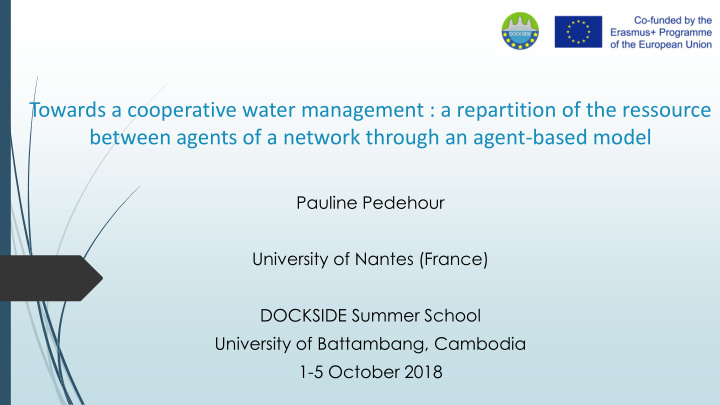



Towards a cooperative water management : a repartition of the ressource between agents of a network through an agent-based model Pauline Pedehour University of Nantes (France) DOCKSIDE Summer School University of Battambang, Cambodia 1-5 October 2018
Background UNESCO proclaimed 2013 as the « United Nations International Year or Water Cooperation » Lack of safe drinking water at home for 3 in 10 people worldwide according to a common report of UNICEF and World Health Organization (2017)
The model Representation of a river by an acyclic and oriented graph with a water flow from the upstream segment of the river to the downstream one. Many agents located along the river with a node of water extraction and a tributary (+ or 0) Trade-off between two choices for the agents: Let some water in the river for the Consume all the water available others in exchange of a monetary to increase their own satisfaction compensation from the agents located downstream.
The principle of cooperation in the model Upstream countries Water Flow Countries in the middle Monetary Units of water of the river compensation Water Flow Downstream countries
Simple utility function in the model Utility function : 𝑽 𝒋 = 𝒄 𝒋 𝒇 𝒋 − 𝒅 𝒋 (𝒇 𝒋 ) − 𝒖 𝒋 𝒙𝒋𝒖𝒊 σ 𝒋 𝒖 𝒋 = 𝟏 where 𝑉 𝑗 is the utility of the agent i 𝑐 𝑗 𝑓 𝑗 is the benefit of i to extract and consume a level of water denoted by 𝑓 𝑗 𝑑 𝑗 (𝑓 𝑗 ) is the cost of the extraction for the agent i 𝑢 𝑗 is the monetary compensation in a cooperation (positive for the upstream agent and negative to the downstream one )
Ƹ Ƹ Ƹ Ƹ The model : example with 3 agents 𝑏 𝑗 the affluent/tributary of the agent i 𝑓 0 = min 𝑏 0 ; 𝑓 0 ∗ 0 𝑓 𝑗 personnal consumption of water of the agent i 𝑓 𝑗 ∗ optimal level of water extraction of the min 𝑏 0 ; 𝑓 0 ∗ − 𝑓 0 agent i 𝑓 i level of water available for the agent i to do a trade-off between his own ∗ } − 𝑓 0 ; e 1 ∗ 𝑓 1 = min 𝑏 1 + min൛𝑏 0 ; 𝑓 0 consumption and cooperation 1 ∗ for 𝑗 = 0, 1, 2 𝑏 𝑗 ≤ 𝑓 𝑗 ∗ − 𝑓 1 ∗ } − 𝑓 0 ; e 1 min 𝑏 1 + min൛𝑏 0 ; 𝑓 0 ∗ } − 𝑓 0 ; e 1 ∗ } − 𝑓 1 ) , e 2 ∗ 𝑓 2 = min (𝑏 2 + minሼ 𝑏 1 + min൛𝑏 0 ; 𝑓 0 2
Agent based-model : the Between agents 0 and 1 different forms of cooperation Direct Between agents 1 and 2 Between all the agents Cooperation Different forms Between 0 and 2 without free of cooperation rider No cooperation Between 0 and 2 with a free Indirect rider and complete information Between 0 and 2 with a free rider and incomplete information Free rider is a market failure that happens when people take advantage of something (a collective good, a common resource) but contribute little or nothing to the efforts or costs
Agent-based model : Interface and process One period Many periods With a procedure to maximize the common level of utility Including a memory on past cooperations Source : author, Master thesis model with Netlogo
Utility maximization and memory : Results Type of cooperation Maximization without Maximization with memory memory Complete 47% 64% cooperation All the other types of 48,4% 34,3% cooperation Without cooperation 4,6% 1,7%
The case of Mekong river Conflicts of use between upstream countries and downstream countries The dams on Mekong river underline this issue of cooperative management between countries The Mekong River Comission in 1995 : Laos, Thailand , Cambodia and Vietnam
Conclusion Results in favor of cooperation in a context of water scarcity excepted in special cases that are not usual in reality - Increasing tributaries and constant/decreasing needs of water The applied case of the Senegal river in favor of cooperation and optimization of water management Website to try the model : http://perso.numericable.fr/tic-et-tac/
Recommend
More recommend